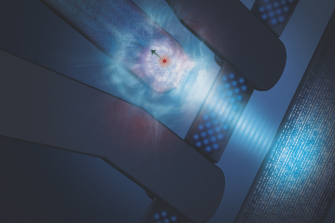Professor Chun Wang | Professor Claude Sammut
Driving innovation in maritime robotics

Through their ongoing collaboration with an innovative technology organisation, OCIUS, Professor Chun Wang and Professor Claude Sammut of UNSW have significantly contributed to the development of a fleet of unassuming vessels used to monitor large stretches of ocean. Unmanned and powered by renewable energy, each one features cutting edge maritime robotics and the latest in machine learning to provide surveillance and insights to those within the fields of defence and environment.
Silent and stealthy, OCIUS’s flagship product, the Bluebottle, is best described as a robotic sailing boat currently used by a range of government agencies both locally and abroad. Powered by solar, wind and waves, each Bluebottle is a mere six metres long but provides unparalleled insights and 24/7 surveillance. “These boats are designed to stay out on the ocean for months at a time and in areas where we don’t have people regularly on patrol,” says Prof. Sammut. “Currently, they’re being used for surveillance of illegal fishing and other suspicious activity.”
Not only can the Bluebottle detect the sounds of propellers and provide footage to those back on dry land – it uses this data to confirm the legitimacy of other vessels. Once the Bluebottle recognises any potential issues, it simply alerts Border Control who then investigate the situation. “Because Australia has such a huge amount of water to patrol, and it can’t all be done by humans, so having an un-crewed fleet of vessels is a big advantage,” explains Prof. Sammut. “People also have limited attention spans and can’t be staring at screens constantly, so the boats help avoid common mistakes.”
As each Bluebottle covers significant distances and is able to undertake a number of challenging missions without risk to human life, the ambition is to eventually have hundreds of Bluebottles spread out in our waters at any given time. “All you need is one human to supervise 100 of them,” adds Prof. Sammut.
Built better together
While both professors are responsible for both software and hardware applications within each vessel, Prof. Wang takes care of sensing and control, and Prof. Sammut works across the software side of the technology.
“OCIUS saw a need for more software development, AI and computer vision,” explains Prof. Sammut. “But they also needed assistance on the mechanical side – the design of the boats, and at the control level, the sensing, too.”
Through this work, Prof. Sammut and Prof. Wang have built strong relationships with OCIUS, allowing them to further collaborate with the organisation on a number of other projects. “We’ve been developing a drone with OCIUS that can be towed under the boat and can dock with another underwater vehicle,” says Prof. Sammut. “We’ve also worked on a project to enhance the radar of the boat, which is vital for the boat to stay autonomous and secure,” adds Prof Wang. “If someone wants to jam your boat – you need to be able to design your radar to be resilient, so there’s quite a bit of work that we’re doing to come up with an improved radar system on board.”
Much of this research however is multi-disciplinary and involves a range of skills and talents. “We don’t just work across the one thing – we’re looking at the mechanical system of the boat, the software, the sensors, the radar, the flick propulsion system and more,” explains Prof. Wang. “Over the years we’ve hired robotics engineers, computer engineers, developed prototypes, software, sensor outputs and more.”
Attendees at the Official Christening ceremony of four (4) new-build Bluebottles at UNSW Randwick Campus: L-R Hon Matt Thistlethwaite MP, Assistant Minister for Defence and Assistant Minister for Veterans Affairs, Robert Dane CEO of Ocius Technology, Rear Admiral Stephen Hughes AM, and Professor Attila Brings Vice-Chancellor of UNSW.
Official Christening ceremony of four (4) new-build Bluebottles BB702, BB703, BB704 and BATHY Uncrewed Surface Vessels (USVs) at UNSW Randwick Campus on 13rd Nov 2023.
Campus connection
All of this work is part of an ongoing partnership between OCIUS and UNSW which involves collaborative research, co-location and student placements. The OCIUS team, majority of whom are UNSW alumni, are based on campus, and enjoy collaboration with researchers and students, as well as access to UNSW facilities and equipment. “Our students have gone and taken what they’ve learned from us and applied it with OCIUS,” says Prof. Sammut. “Now, 75% of their employees are our graduates,” he adds. “We’ve had a big influence in the sense that a lot of the tech we’ve developed has gone with our graduates to the company.”
For both Prof. Sammut and Prof. Wang, being able to contribute to the development of maritime robotic autonomous systems has been hugely important, given the impact this research is set to have. “These boats might not interact directly with the community, but they interact indirectly,” says Prof. Sammut. “From protecting the country through defence applications to monitoring the Great Barrier Reef and seeing the effects of climate change – they’ll have a big impact.”
Share this story
Digital Transformation
Read more
Get in touch and see what’s possible.
Ask how we can help your business, industry, or market through collaboration.



